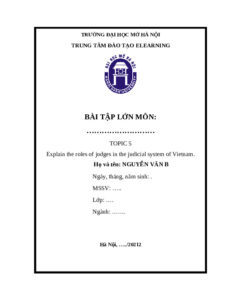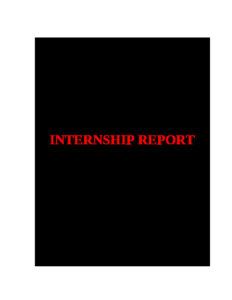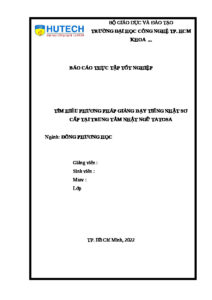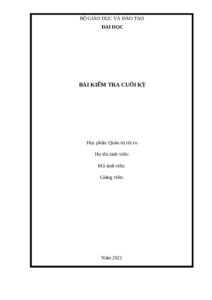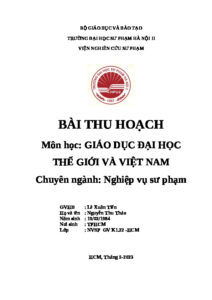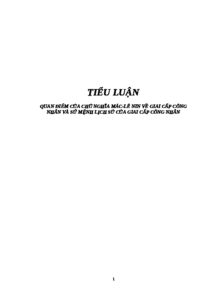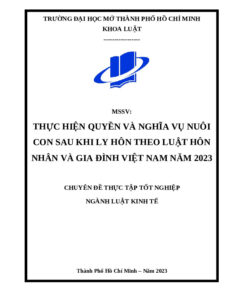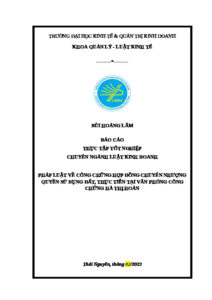Solutions To Attract Foreign Direct Investment (Fdi) In Hanoi During Covid-19 Pandemic
Đề tài: giải pháp thu hút vốn đầu tư trực tiếp nước ngoài (fdi) vào Hà Nội trong thời kỳ đại dịch Covid-19
Giới thiệu Topic: solutions to attract foreign direct investment (fdi) in hanoi during covid-19 pandemic
Introduction
Bạn đang xem trước 15 trang tài liệu Solutions To Attract Foreign Direct Investment (Fdi) In Hanoi During Covid-19 Pandemic, để xem tài liệu hoàn chỉnh bạn click vào nút DOWNLOAD ở trên
TOPIC: SOLUTIONS TO ATTRACT FOREIGN DIRECT INVESTMENT (FDI) IN HANOI DURING COVID-19 PANDEMIC INTRODUCTION Contents 1. Rational for topic..............................................................................................................3 2. Previous studies.................................................................................................................5 2.1 Foreign studies...........................................................................................................5 2.2 Domestic studies.........................................................................................................8 3. Research objectives.........................................................................................................10 4. Research questions..........................................................................................................11 5. Research subject and scope............................................................................................11 6. Research methods...........................................................................................................11 7. Expected layout...............................................................................................................11 CHAPTER 1: THE THEORETICAL BASIS OF ATTRACTING FOREIGN DIRECT INVESTMENT (FDI) INTO THE LOCAL AREA............................................................12 1.1 Theoretical Basis of Foreign Direct Investment (FDI).........................................12 1.1.1 The concept of FDI...........................................................................................12 1.1.2 Characteristics of FDI......................................................................................13 1.1.3 Forms of FDI....................................................................................................14 1.1.4 The impact of FDI on economy.......................................................................19 1.2 The rationale for attracting foreign direct investment (FDI) into the local area 28 1.2.1 Concepts and perspectives of attracting FDI into the local area.................28 1.2.2 Policies to attract FDI into the local area.......................................................29 1.3 Factors affecting local attraction of FDI...............................................................32 1.3.1 Macro-environmental factors.........................................................................32 1.3.2 Internal factors of places receiving FDI.........................................................32 CHAPTER 2: THE REAL SITUATION OF ATTRACTING FDI INTO HANOI IN THE CONTEXT OF COVID-19 PANDEMIC...................................................................36 2.1 The socio-economic characteristics of Ha Noi affect the attractiveness of FDI.36 2.1.1 Natural characteristics.....................................................................................36 2.1.2 Population, Education and Training..............................................................39 2.1.4 Economy............................................................................................................44 2.1.5 Development of COVID-19 pandemic in Hanoi............................................45 2.2 The status of attracting FDI into Hanoi in the context of Covid-19 pandemic..46 2.2.1 Policies to attract foreign direct investment in Hanoi..................................46 2.2.2 Situation of FDI into Hanoi City.....................................................................52 Areas attracting FDI.......................................................................................................54 2.2.3 Efficiency of Hanoi's utilization of FDI..........................................................57 2.3 Overall assessment of attracting FDI into Hanoi in the context of the Covid-19 pandemic.............................................................................................................................58 2.3.1 Achievements....................................................................................................58 2.3.2 Limitations and its causes................................................................................62 CHAPTER 3: SOLUTIONS TO INCREASE THE ATTRACTIVENESS OF FDI TO HA NOI DURING THE RECOVERY OF THE PANDEMIC..........................................65 3.1 Direction for Hanoi Municipal government to Attract FDI in the Near Future 65 3.2 Solutions to increase the attractiveness of FDI to Hanoi during the recovery of the pandemic.......................................................................................................................66 3.2.1 Unifying orientation in attracting and using FDI.........................................66 3.2.2 Formulate policies to support the market and product consumption for foreign-invested enterprises..........................................................................................66 3.2.3 Determining the audience for policies to attract FDI...................................67 3.2.4 Using attracted FDI capital in the most effective way..................................68 3.3 Other recommendations......................................................................................68 REFERENCES.......................................................................................................................71 1. Rational for topic FDI projects have increased important sources of capital for development investment; Contribute to GDP growth and national budget revenue; Increase the proportion of exports; Improve labor productivity, make positive contributions to local economic growth, and promote the industrialization and modernization of the country. The complex development of COVID-19 pandemic and anti-epidemic measures have brought many challenges and risks to the investment and business cooperation activities of foreign enterprises in Vietnam, especially in Hanoi. Up to now, the city has attracted 6,625 effective foreign investment projects with a total registered capital of about 48.7 billion US dollars. Especially in 2018 and 2019, Hanoi ranked first in attracting foreign investment in China, with capital of 7.5 billion US dollars and 8.67 billion US dollars respectively. However, in 2020, under the severe influence of COVID-19 pandemic in Hanoi, foreign direct investment capital dropped abruptly to 3.83 billion US dollars. In the first nine months of 2021, because Ha Noi is still affected by many negative impacts of COVID-19 pandemic, the registered FDI capital is only 1. 28 billion US dollars; This contributes to the overall socio-economic development of the city, accounting for about 10% of the total budget revenue of the city, 12.6% of the development investment capital of the whole city, 30% of the total employment and 45% of the total import and export volumes. In the past, many Japanese and German companies had a policy of withdrawing from China and moving to Vietnam. And other countries/regions with Vietnam as the top priority. Now some of them are no longer withdrawing from China, some are transferor orders back to China, some are still in Vietnam, but more choices are other countries/regions. Vietnam in general and Hanoi in particular are losing opportunities. However, according to the Nikkei News, by 2021, Vietnam's anti-epidemic effect is generally the same as Hanoi's. Especially, it has greatly affected the investment decisions of foreign investors. European companies also said that 18% of their orders have been moved out of Vietnam, and American companies are also considering reducing their orders. According to the latest survey by the European Chamber of Commerce, about one third of the members of the European Chamber of Commerce have to transfer production facilities from Vietnam to other countries. Recently, the French Chamber of Commerce and Industry in Vietnam (CCIFV) conducted a survey to assess the difficulties and limitations faced by French SMEs due to the impact of COVID-19 epidemic. While the Vietnam-EU Free Trade Agreement (EVFTA) has been in force for a year, Vietnam-France trade fell 12.7% to 6.34 billion euros in 2020, compared with 77.4 billion euros in the same period, according to the survey, 26 billion euros in 2019. Many investors and experts are unable to enter Vietnam to start the project. The survey also showed that 24% of French businesses operating in Vietnam for less than 10 years and 37% of those operating in Vietnam for more than 10 years are struggling to survive. Seventy-eight percent of businesses said activity had dropped by at least 40 percent in the past two months. Seventy-two percent of them reply that their activities must be stopped and reduced by 80 percent. Only 17% believe they have had little or no impact from the pandemic. In practice, the difficulties faced by enterprises, such as social isolation and limited contacts, make it difficult for enterprises to meet customers and foreign experts to return to Vietnam, which affects the income of enterprises. Due to reduced orders, delayed payment, delayed decision-making … In addition, logistics services are also very difficult under the condition of insufficient supply and increased export costs. The cost of 3T (3 sites: on-site production, on-site dining, and on-site rest in turn according to the production team) is a huge challenge, and the work is limited. Therefore, under the background of COVID-19 epidemic, it is very necessary to study and find solutions to attract foreign direct investment (FDI) in Ha Noi. For the above reasons, the author decided to take “SOLUTIONS TO ATTRACT FOREIGN DIRECT INVESTMENT (FDI) IN HANOI DURING COVID-19 PANDEMIC” as the topic of her graduation thesis. and on-site rest in turn according to the production team) is a huge challenge, and the work is limited. Therefore, under the background of COVID-19 epidemic, it is very necessary to study and find solutions to attract foreign direct investment (FDI) in Ha Noi. For the above reasons, the author decided to take “SOLUTIONS TO ATTRACT FOREIGN DIRECT INVESTMENT (FDI) IN HANOI DURING COVID-19 PANDEMIC” as the topic of her graduation thesis. and on-site rest in turn according to the production team) is a huge challenge, and the work is limited. Therefore, under the background of COVID-19 epidemic, it is very necessary to study and find solutions to attract foreign direct investment (FDI) in Ha Noi. For the above reasons, the author decided to take “SOLUTIONS TO ATTRACT FOREIGN DIRECT INVESTMENT (FDI) IN HANOI DURING COVID-19 PANDEMIC” as the topic of her graduation thesis. 2. Previous studies 2.1 Foreign studies Authors Lv Na and WS Lightfoot (2006), based on a multivariable regression model, studied 30 different areas in East, Central and Western China. The research results show that the factors affecting the imbalance in the allocation of FDI to localities in China are: market size, labor quality, labor costs, openness of and the reform process. LS Pheng and J. Hongbin (2006) studied the investment decisions of 31 multinational companies in the construction industry in China in 2001 based on Dunning's OLI theoretical model. The results show that: ownership advantages affect the foreign investment decisions of Chinese companies; As for location advantage, the study results show that a large group of Chinese MNCs in the host country influence the decisions of other Chinese MNCs. Fetscherin M., Voss H. et al. (2010) synthesized FDI trends in China over 30 years by examining 422 articles by 625 authors that were published in 151 journals between 1979 and 2008. According to these authors, changes Economic changes and reforms have improved China's positional advantage. Special economic zones are bound by local resources, infrastructure development and industrial facilities. In addition, economic development, educational attainment, wage costs, institutional and supportive environment in the provinces in China are important factors in increasing the size of FDI. Behrooz Shahmoradi and Mostafa Baghbanyan (2011) conducted a study on factors affecting FDI inflows into 25 developing countries in the period 1990 - 2007. The analysis results show the size, market size, openness. Economic openness, labor force availability, official development assistance, mobile phones, internet and technology have an impact on FDI inflows into developing countries. Lord Andzie Quainoo's (2011) research work in 56 countries in Africa (SSA) in the period 1984-2005 seeks to answer the question: why countries in Africa attract FDI poorly fruit? Why can't the agriculture of those countries experience the same agricultural transformation as countries in Asia and Latin America? The research results show that: economic infrastructure is an important factor in increasing FDI capital, besides that countries are endowed with natural resources or have large markets and favorable investment environment. profits will call for more foreign investment. In addition, a trained workforce, macroeconomic stability, openness to FDI, an effective legal system, Less corruption and political stability will promote FDI. The analysis results also show that countries with small markets or countries lacking natural resources can increase the scale of FDI by strengthening open policies to support investment, improving organizational structure. government office. In addition, regional economic cooperation can also increase FDI into the African region. The authors also explore the causes of agriculture in underdeveloped countries and low agricultural productivity. The results show that: the factors affecting agricultural productivity in tropical African countries are: the use of fertilizers, telephones, irrigation and rainfall have positive effects on agricultural productivity; Research by JC Anyanwu (2012) shows that there is a positive relationship between market size (urban population), openness to trade, high levels of government spending, and an increase in overseas migration. remittances into Africa, the ability to accumulate regional markets for FDI inflows in this continent. However, the increase Financial development has been found to impede FDI inflows. Especially available natural resources (especially for oil) strongly attract FDI into Africa. Research by Sapna Hooda (2011) on foreign direct investment in India in the period 1991-2009 shows that: the main factor that positively affects FDI attraction to India is the expansion of the commercial market. , foreign exchange reserves, financial status; while research and development costs, the exchange rate is the main factor impeding FDI inflows into the country. Neeraj Dhingra and HS Sidhu (2011) used exploratory factor analysis (EFA) to identify the determinants of FDI inflows into India. The analysis results show that there are four main factors that play the most important role in attracting FDI into India. The first is the financial power of the state. The second most important factor is the level of development of the country, which is reflected in the high human development index, high literacy rate, increase in per capita income, decrease in corruption and poverty index. high national competition. The third factor identified is the size of the market. India is second only to China, the country with the second largest population in the world, so it is a huge market, full of potential for foreign investors. The final factor of interest to foreign investors identified in the analysis is the quality of India's infrastructure. The author Kangning Xu (2012) in the study on increasing FDI capital for developing countries, used multivariable regression model to analyze. Research results show that: in order to attract investors to a developing country, the factors that have the most influence on increasing the size of investment capital are: Geographical location and level of investment base. Infrastructure; Market size; The country's export policy; The country's natural resources; Labor resources in line with investor's requirements; Risks to a country's economic and political environment. Ab Quyoom Khachoo and Mohd Imran Khan (2012) relied on a panel data model using a sample of 32 developing countries from 1982 to 2008 to find out the factors affecting FDI inflows to developing countries. this family. The results show that all variables such as GDP, total reserves (including gold, special drawing rights, reserves at IMF), electricity consumption, wage rate, trade openness to FDI inflows (foreign minus openness) has a strong impact on FDI inflows. In the study of Eduarda Martins Correa da Silveira, Jorge Augusto Dias Samsonescu et al. (2017), The authors identified the determinants of foreign direct investment (FDI) in Brazil through empirical analysis for the period 2001-2013 using the vector error correction model (VECM). Research shows that investors pursue strategy: search the market and look for efficiency when targeting the Brazilian market. The research results show that the factors affecting the investment decisions of foreign investors in Brazil are: the level of development and stability of the economy (GDP growth rate), the size of domestic market, exchange rate. 2.2 Domestic studies Bui Tuan Anh (2011) analyzed theories explaining the causes of FDI such as market imperfection theory, internalization theory, eclectic theory (OLI). The author applies Dunning's eclectic theory to study the case of Honda Motorcycle Company - Vietnam and ANZ Bank - Vietnam. From the research results, the author believes that Dunning's eclectic theory is the clearest method to study FDI in Vietnam and proves that FDI enterprises improve the level of production technology and apply modern organizational form of management, service provision and marketing to promote Vietnam's advantages in competition. Phan Thi Quoc Huong (2014) has reviewed theories that determine the factors affecting investment decisions of foreign investors such as international trade theory, monopoly theory, circular theory, etc. product life cycle, internalization theory, OLI model. The author has applied the OLI model to examine the determinants of FDI location to study the location factors that determine FDI inflows into Vietnam. According to this author, there are 23 factors affecting FDI attraction that are concretized into 94 variables in different econometric models affecting FDI attraction in the world and in Vietnam. The author has tested according to the differential GMM estimation method, showing that there are 3 factors that directly affect the attraction of FDI in Vietnam, namely the policy framework, the market search engine and the resource search engine. Factors such as efficient search engines, institutional quality and historical information had no influence on FDI attraction to Vietnam. Also using the differential GMM estimation method, the author commented that factors such as economic management of the local government, market search engine, efficient search engine and FDI accumulation effect are affects the distribution of FDI among localities... market engine and resource search engine. Factors such as efficient search engines, institutional quality and historical information had no influence on FDI attraction to Vietnam. Also using the differential GMM estimation method, the author commented that factors such as economic management of the local government, market search engine, efficient search engine and FDI accumulation effect are affects the distribution of FDI among localities... market engine and resource search engine. Factors such as efficient search engines, institutional quality and historical information had no influence on FDI attraction to Vietnam. Also using the differential GMM estimation method, the author commented that factors such as economic management of the local government, market search engine, efficient search engine and FDI accumulation effect are affects the distribution of FDI among localities... Nguyen Minh Tien (2014) argues that there are many theories that attempt to explain the determinants of FDI. These theories are a necessary step to develop a theoretical framework for FDI attraction policy. The author has modeled the factors that attract FDI into Vietnam and emphasized that, there is a set of many independent variables that have an impact on FDI, this set depends on space and time when analyzing. price. Author Thu Thi Hoang (2006) used the OLS regression method for quarterly time series data for the period 1998 - 2005 of the General Statistics Office of Vietnam to study the factors affecting FDI in Vietnam. Male. According to the regression results, variables related to market size and growth, infrastructure, openness of the economy, exchange rate and Asian financial crisis are statistically significant in the impact of the financial crisis. affecting FDI flows into Vietnam. The variables related to the quality of human resources and the inflation rate were determined not to be statistically significant. Research results of Hoang Thi Thu are limited to the OLS regression model, The model has not been tested, so the estimated results may not be accurate. On the other hand, due to the inconsistent data used, some criteria are represented by the average annual model, so the regression results have not shown high accuracy. Dinh Thi Thanh Binh (2009) used Tobit regression model to analyze statistical survey data of foreign enterprises operating in Vietnam in the period 2000 - 2005. The analysis results show the selection of location. of foreign companies in Vietnam is driven by factors of traditional location advantages, agglomeration effects and mechanisms implemented by local authorities. In his research, Ho Nhut Quang (2010) used the OLS method to study the factors affecting FDI inflows into Vietnam in the period 1988-2010. The test results show an increase in economic variables such as: real gross domestic product, total consumption in the economy, the value of state investment in industry and agriculture, and the value of trade. Internationalization has a significant impact on the increase in FDI inflows into Vietnam. In this study, the author has performed a number of tests on multicollinearity, variable variance and autocorrelation. However, the author has not tested the stationarity for time series data, so the regression results are not highly reliable. The research work of Nguyen Manh Toan (2010) is based on 258 questionnaires collected from foreign invested companies operating in 3 cities: Hanoi, Ho Chi Minh City and Da Nang. , has shown that some factors are rated as more important than others. Specifically: technical infrastructure, incentives and support from local authorities, low operating costs are the most important factors that have a decisive influence when considering foreign investors. choosing an investment location in Vietnam. The potential market, the abundance of human resources and natural resources are also taken into account next. Final, From a sample of 398 FDI enterprises in Vietnam, the authors Thi Lan Anh Nguyen, Ali Saleh et al. (2013) performed multiple structural modeling (SEM) regression to determine the motivations of multinational companies to invest in service industries in Vietnam. The test results only support the hypothesis related to market search engine (with 1% significance level) and government policy impact (with 5% significance level), while the related hypothesis to effective search engines and cultural gaps, business networks are rejected. The research work of Hoang Chi Cuong (2013) on the impact of trade liberalization on FDI inflows into Vietnam used the Gravity Model GM (Gravity Model), using period panel data. 1995 - 2011 from 18 important foreign investment partners of Vietnam and Hausman-Taylor (1981) estimation method. The estimated results show that: trade liberalization has a great impact on FDI inflows into Vietnam; There is no convincing evidence that the bilateral/multilateral trade agreements that Vietnam has joined or signed recently promote FDI inflows into Vietnam. Nguyen Thi Lien Hoa and Bui Thi Bich Phuong (2014) studied the factors affecting FDI in developing countries. The authors used a sample of low- and middle-income developing countries during the period (2000 - 2012), including Vietnam, for analysis using the Feasible Generalized Least Square (FGLS) method. Research results show that: market size, total reserves, facilities, labor costs and trade openness are the factors affecting FDI inflows into developing countries. 3. Research objectives The research aims at analyze and assess the current situation of attracting foreign direct investment (FDI) in Hanoi in the context of the complex COVID-19 pandemic. On this basis, solutions are put forward to improve the ability to attract FDI to Ha Noi during the recovery of the pandemic. 4. Research questions In order to achieve the research objectives, this topic focuses on address he following specific research question: (1) What is the situation of attracting foreign direct investment (FDI) in Hanoi in the context of COVID-19 pandemic? (2) What cause be done to help Ha Noi its ability to attract FDI during the recovery of the pandemic? 5. Research subject and scope The object of the research is Hanoi City's activities to attract foreign direct investment capital in the context of the Covid-19 outbreak. Research scope: Spatial scope: Research is carried out within the scope of Hanoi's FDI attraction activities. Spatial scope: study data were collected for the period from 2018 to 2021. 6. Research methods 7. Expected layout In addition to the Introduction, Conclusion and Reference part, the research consits of 3 chapters as follow: Chapter 1: The theoretical basis of attracting foreign direct investment (FDI) into the local area Chapter 2: The real situation of attracting FDI into Hanoi in the context of Covid-19 pandemic Chapter 3: Solutions to increase the attractiveness of FDI to Ha Noi during the recovery of the pandemic CHAPTER 1: THE THEORETICAL BASIS OF ATTRACTING FOREIGN DIRECT INVESTMENT (FDI) INTO THE LOCAL AREA 1.1 Theoretical Basis of Foreign Direct Investment (FDI) 1.1.1 The concept of FDI Foreign direct investment (FDI) is the process by which citizens in a country, namely the host country, gain ownership of assets for the purpose of controlling production, distribution and other activities. of an enterprise located in another country (or can be understood as the host country). (Imad A. Moosa, 2002). Talking about this concept, according to the IMF (1993): “Foreign direct investment (FDI) is an investment activity made to achieve long-term benefits with an enterprise operating in the territory of an economy. economy other than that of the host country, but the purpose of the investor is to gain real management rights over that enterprise”. In addition, in the UNCTAD World Investment Report (1999), FDI is defined as 'an investment involving a relationship with a long-term interest and control by a legal entity residing in an economy (foreign direct investor or parent company) to with an enterprise in an economy other than that of the investor (also known as an FDI enterprise, a foreignaffiliated or associated enterprise)'. A long-term relationship also implies a significant degree of influence in the management of that business. Direct investment involves both the initial transaction between two entities and any subsequent capital transactions between them and between subsidiaries, whether legal or not (OECD, 1996). . From the perspective of Vietnamese law, The difference of FDI from the form of indirect investment (FPI) is firstly in terms of time, when FDI has a long-term nature as mentioned in the above definitions, while FPI usually takes place in a short period of time. short term and the main source of revenue is from investing in stocks or bonds. The common difference between these two forms is 'control' and 'control'. (Imad A. Moosa, 2002). While indirect investment is just an investment with the purpose of profit, without control over a business or an investment for long-term benefits, direct investment is geared towards controlling the assets of the business. According to the IMF, if the investor holds from 10% of the enterprise's asset value, they are counted as direct investors. However, this is still relative, because in reality there are cases where the owner's percentage of assets in the business is less than 10%, but they still have the right to directly manage the business. While there are many cases where the owner's ownership ratio is greater than 10%, they are still only indirect investors (IFC 1997, p.9). Thus, foreign investment activities are classified as FDI when they include the following characteristics: (i) control through the ownership of a substantial proportion of shares in the receiving enterprise by the investing enterprise. investment; (ii) there is a transfer of part of the assets, production or retail of the investment company to the host country company. 1.1.2 Characteristics of FDI Foreign direct investment has the following main characteristics: Firstly, associated with the movement of investment capital, i.e. money and other assets between countries, resulting in an increase in the amount of money and assets of the host country's economy and a decrease in the amount of money in the host country's economy. money and assets of the country where the investment is going. Second, it is conducted through capital investment to establish new businesses (joint venture or 100% ownership), business cooperation contracts, acquisition of existing branches or businesses, purchase of shares in control or conduct business consolidation and transfer. Third, a foreign investor is the complete owner of the investment capital or jointly owns the investment capital with a certain percentage sufficient to participate in the direct management of the enterprise's operations. Fourth, is private investment, regulated by market relations on a global scale, less affected by political relations between countries, governments and fundamental goals. version is always high profit. Fifth, investors directly control and manage the movement of investment capital. Sixth, FDI includes investment from abroad into the country and investment from inside the country abroad, thus including capital moving into a country and capital moving out of that country's economy. . Seventh, FDI is mainly carried out by transnational companies. The above characteristics are common to all FDI activities worldwide. For Vietnam, the process of receiving FDI has been going on for 20 years and the above
Tài liệu liên quan
Topic 5 Explain the roles of judges in the judicial system of vietnam
Topic 5 Explain the roles of judges in the judicial system of vietnam Chủ đề 5 Giải thích vai trò của thẩm phán trong hệ thống tư pháp Việt Nam
Solutions To Mprove The Operational Performance Of Vietnam Bank For Industry And Trade Securities Joint Stock Company Vietinbank Securities
Topic: Solutions To Mprove The Operational Performance Of Vietnam Bank For Industry And Trade Securities Joint Stock Company (Vietinbank Securities)
Báo Cáo Thực Tập Ngoại Ngữ Tại Đại Học Bình Dương
Báo Cáo Thực Tập Ngoại Ngữ Tại Đại Học Bình Dương Ministry of training and education Bình dương university Faculty of foreign languages
Báo Cáo Thực Tập Chuyên Ngành Ngôn Ngữ Anh Đại Học Hải Phòng
Báo Cáo Thực Tập Chuyên Ngành Ngôn Ngữ Anh Đại Học Hải Phòng, dành cho các bạn sinh viên đang tìm kiếm đề tài ngành ngoại ngữ anh
A Study On Activities To Improve In Service Students Reading Skills At Tay Nguyen University
The Outline Of Graduation Assignment Title: A Study On Activities To Improve In-Service Students’ Reading Skills At Tay Nguyen University
Phương Pháp Giảng Dạy Tiếng Nhật Sơ Cấp Tại Nhật Ngữ Tatosa
Báo Cáo Thực Tập Tốt Nghiệp Tìm Hiểu Phương Pháp Giảng Dạy Tiếng Nhật Sơ Cấp Tại Trung Tâm Nhật Ngữ Tatosa Ngoài phần mở đầu và kết luận, nội…
Xem nhiều nhất
Bài Kiểm Tra Cuối Kỳ Học Phần Quản Trị Rủi Ro Có Lời Giải
Bài Kiểm Tra Cuối Kỳ Học Phần Quản Trị Rủi Ro Có Lời Giải Câu 1: Chức danh nhân viên kinh doanh bán hàng có các công việc nào phải…
Bài Thu Hoạch Môn Học Giáo Dục Đại Học Thế Giới Và Việt Nam Chuyên Ngành Nghiệp Vụ Sư Phạm
Bài thu hoạch Môn học: giáo dục đại học thế giới và việt nam Chuyên ngành: nghiệp vụ sư phạm
Tiểu Luận Quan Điểm Của Chủ Nghĩa Mác-Lê Nin Về Giai Cấp Công Nhân Và Sứ Mệnh Lịch Sử Của Giai Cấp Công Nhân
Tiểu Luận Quan Điểm Của Chủ Nghĩa Mác-Lê Nin Về Giai Cấp Công Nhân Và Sứ Mệnh Lịch Sử Của Giai Cấp Công Nhân
Khóa Luận Thực Hiện Quyền Và Nghĩa Vụ Nuôi Con Sau Khi Ly Hôn Theo Luật Hôn Nhân Và Gia Đình Việt Nam Năm 2023
Chuyên Đề Thực Tập Tốt Nghiệp Thực Hiện Quyền Và Nghĩa Vụ Nuôi Con Sau Khi Ly Hôn Theo Luật Hôn Nhân Và Gia Đình Việt Nam Năm 2023 Mục…
Tiểu Luận Nguồn Gốc Ra Đời Của Nhà Nước Và Pháp Luật Theo Học Thuyết Chủ Nghĩa Mác- Lênin
Tiểu Luận Nguồn Gốc Ra Đời Của Nhà Nước Và Pháp Luật Theo Học Thuyết Chủ Nghĩa Mác- Lênin dành cho các bạn sinh viên đang tìm kiếm về bài…
Pháp Luật Về Công Chứng Hợp Đồng Chuyển Nhượng Quyền Sử Dụng Đất, Thực Tiễn Tại Văn Phòng Công Chứng Hà Thị Hoàn
Báo cáo Thực tập tốt nghiệp Chuyên ngành luật kinh doanh pháp luật về công chứng hợp đồng chuyển nhượng quyền sử dụng đất, thực tiễn tại văn phòng công…


